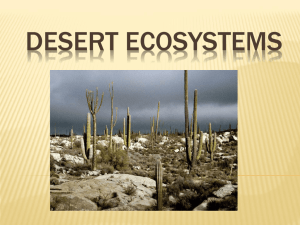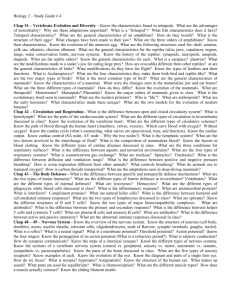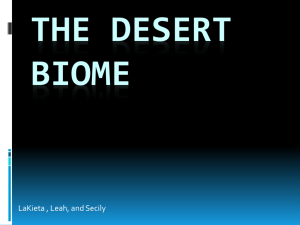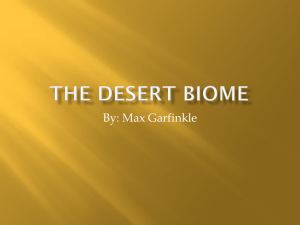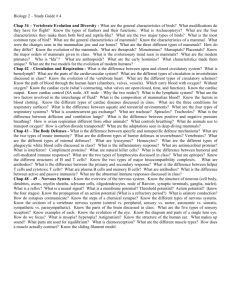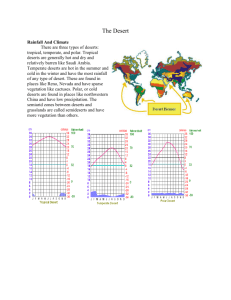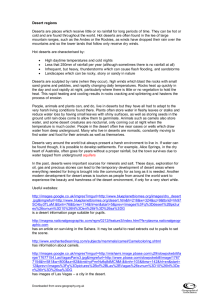Biology 2 * Study Guide # 2
advertisement
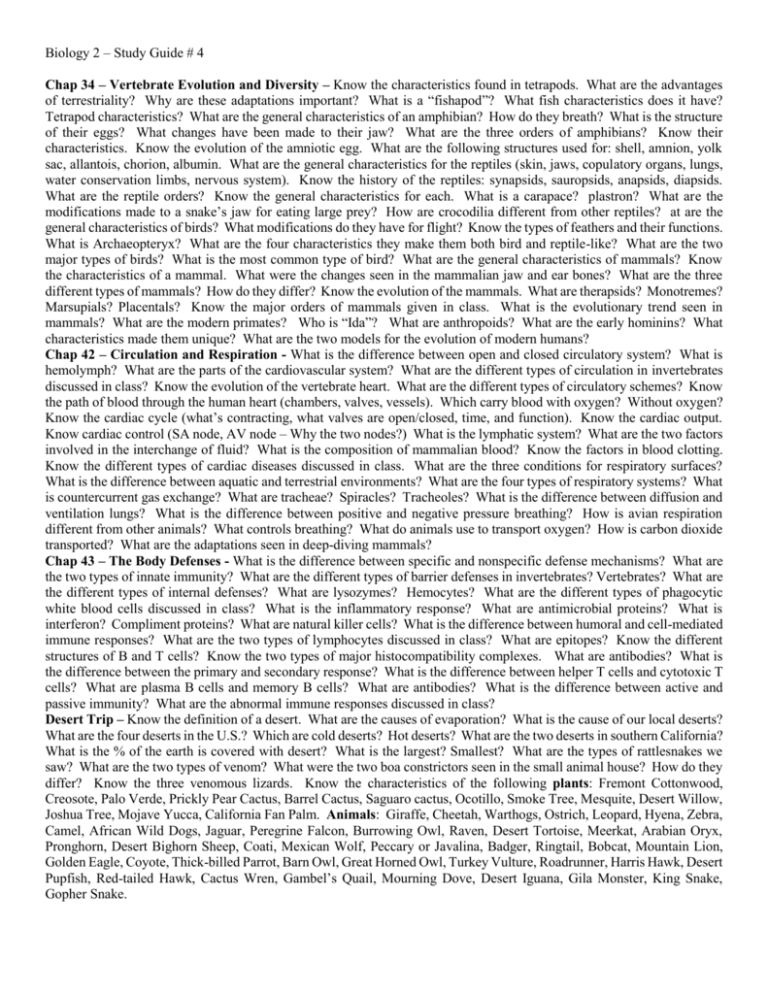
Biology 2 – Study Guide # 4 Chap 34 – Vertebrate Evolution and Diversity – Know the characteristics found in tetrapods. What are the advantages of terrestriality? Why are these adaptations important? What is a “fishapod”? What fish characteristics does it have? Tetrapod characteristics? What are the general characteristics of an amphibian? How do they breath? What is the structure of their eggs? What changes have been made to their jaw? What are the three orders of amphibians? Know their characteristics. Know the evolution of the amniotic egg. What are the following structures used for: shell, amnion, yolk sac, allantois, chorion, albumin. What are the general characteristics for the reptiles (skin, jaws, copulatory organs, lungs, water conservation limbs, nervous system). Know the history of the reptiles: synapsids, sauropsids, anapsids, diapsids. What are the reptile orders? Know the general characteristics for each. What is a carapace? plastron? What are the modifications made to a snake’s jaw for eating large prey? How are crocodilia different from other reptiles? at are the general characteristics of birds? What modifications do they have for flight? Know the types of feathers and their functions. What is Archaeopteryx? What are the four characteristics they make them both bird and reptile-like? What are the two major types of birds? What is the most common type of bird? What are the general characteristics of mammals? Know the characteristics of a mammal. What were the changes seen in the mammalian jaw and ear bones? What are the three different types of mammals? How do they differ? Know the evolution of the mammals. What are therapsids? Monotremes? Marsupials? Placentals? Know the major orders of mammals given in class. What is the evolutionary trend seen in mammals? What are the modern primates? Who is “Ida”? What are anthropoids? What are the early hominins? What characteristics made them unique? What are the two models for the evolution of modern humans? Chap 42 – Circulation and Respiration - What is the difference between open and closed circulatory system? What is hemolymph? What are the parts of the cardiovascular system? What are the different types of circulation in invertebrates discussed in class? Know the evolution of the vertebrate heart. What are the different types of circulatory schemes? Know the path of blood through the human heart (chambers, valves, vessels). Which carry blood with oxygen? Without oxygen? Know the cardiac cycle (what’s contracting, what valves are open/closed, time, and function). Know the cardiac output. Know cardiac control (SA node, AV node – Why the two nodes?) What is the lymphatic system? What are the two factors involved in the interchange of fluid? What is the composition of mammalian blood? Know the factors in blood clotting. Know the different types of cardiac diseases discussed in class. What are the three conditions for respiratory surfaces? What is the difference between aquatic and terrestrial environments? What are the four types of respiratory systems? What is countercurrent gas exchange? What are tracheae? Spiracles? Tracheoles? What is the difference between diffusion and ventilation lungs? What is the difference between positive and negative pressure breathing? How is avian respiration different from other animals? What controls breathing? What do animals use to transport oxygen? How is carbon dioxide transported? What are the adaptations seen in deep-diving mammals? Chap 43 – The Body Defenses - What is the difference between specific and nonspecific defense mechanisms? What are the two types of innate immunity? What are the different types of barrier defenses in invertebrates? Vertebrates? What are the different types of internal defenses? What are lysozymes? Hemocytes? What are the different types of phagocytic white blood cells discussed in class? What is the inflammatory response? What are antimicrobial proteins? What is interferon? Compliment proteins? What are natural killer cells? What is the difference between humoral and cell-mediated immune responses? What are the two types of lymphocytes discussed in class? What are epitopes? Know the different structures of B and T cells? Know the two types of major histocompatibility complexes. What are antibodies? What is the difference between the primary and secondary response? What is the difference between helper T cells and cytotoxic T cells? What are plasma B cells and memory B cells? What are antibodies? What is the difference between active and passive immunity? What are the abnormal immune responses discussed in class? Desert Trip – Know the definition of a desert. What are the causes of evaporation? What is the cause of our local deserts? What are the four deserts in the U.S.? Which are cold deserts? Hot deserts? What are the two deserts in southern California? What is the % of the earth is covered with desert? What is the largest? Smallest? What are the types of rattlesnakes we saw? What are the two types of venom? What were the two boa constrictors seen in the small animal house? How do they differ? Know the three venomous lizards. Know the characteristics of the following plants: Fremont Cottonwood, Creosote, Palo Verde, Prickly Pear Cactus, Barrel Cactus, Saguaro cactus, Ocotillo, Smoke Tree, Mesquite, Desert Willow, Joshua Tree, Mojave Yucca, California Fan Palm. Animals: Giraffe, Cheetah, Warthogs, Ostrich, Leopard, Hyena, Zebra, Camel, African Wild Dogs, Jaguar, Peregrine Falcon, Burrowing Owl, Raven, Desert Tortoise, Meerkat, Arabian Oryx, Pronghorn, Desert Bighorn Sheep, Coati, Mexican Wolf, Peccary or Javalina, Badger, Ringtail, Bobcat, Mountain Lion, Golden Eagle, Coyote, Thick-billed Parrot, Barn Owl, Great Horned Owl, Turkey Vulture, Roadrunner, Harris Hawk, Desert Pupfish, Red-tailed Hawk, Cactus Wren, Gambel’s Quail, Mourning Dove, Desert Iguana, Gila Monster, King Snake, Gopher Snake.
